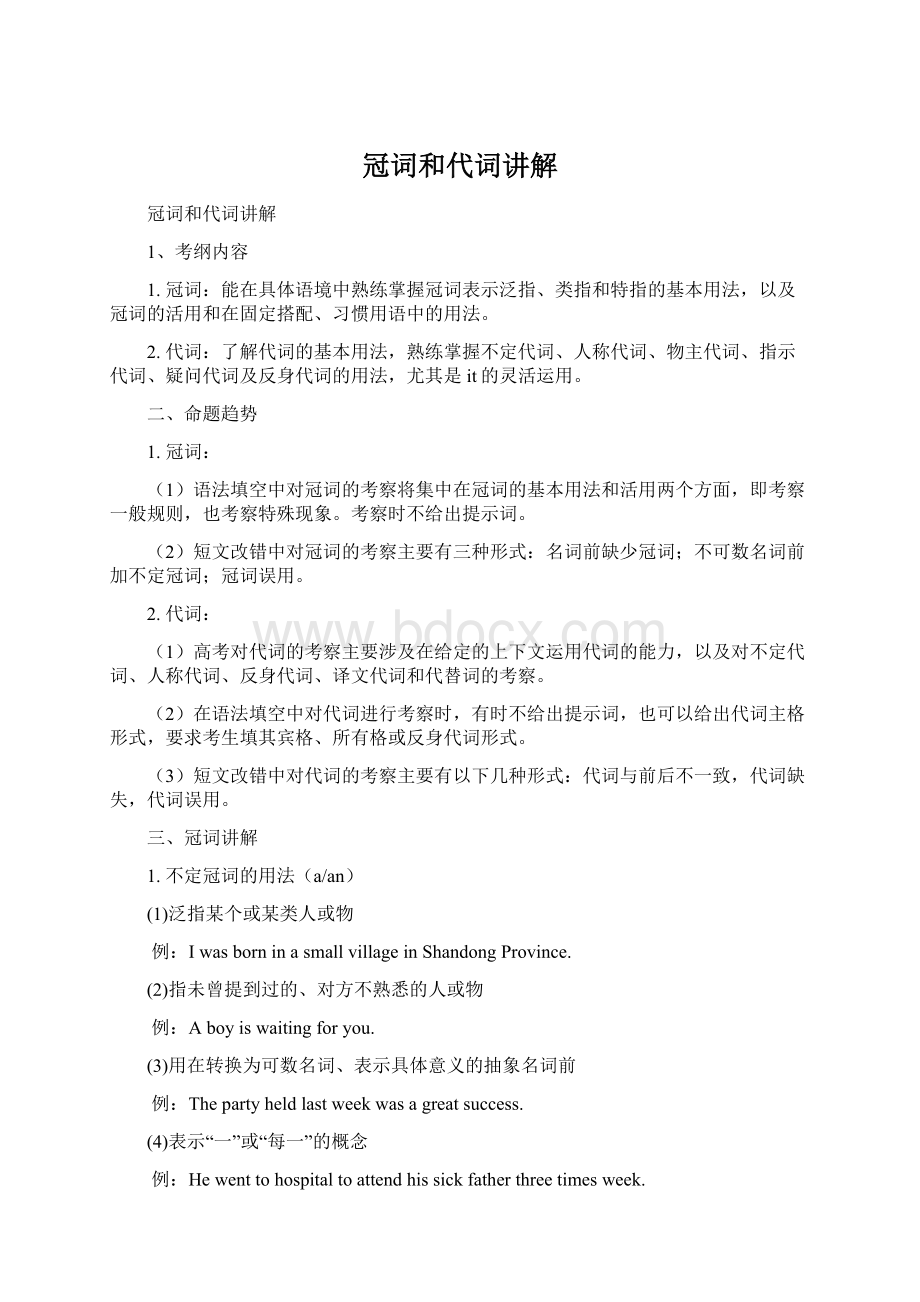冠词和代词讲解.docx
《冠词和代词讲解.docx》由会员分享,可在线阅读,更多相关《冠词和代词讲解.docx(9页珍藏版)》请在冰豆网上搜索。

冠词和代词讲解
冠词和代词讲解
1、考纲内容
1.冠词:
能在具体语境中熟练掌握冠词表示泛指、类指和特指的基本用法,以及冠词的活用和在固定搭配、习惯用语中的用法。
2.代词:
了解代词的基本用法,熟练掌握不定代词、人称代词、物主代词、指示代词、疑问代词及反身代词的用法,尤其是it的灵活运用。
二、命题趋势
1.冠词:
(1)语法填空中对冠词的考察将集中在冠词的基本用法和活用两个方面,即考察一般规则,也考察特殊现象。
考察时不给出提示词。
(2)短文改错中对冠词的考察主要有三种形式:
名词前缺少冠词;不可数名词前加不定冠词;冠词误用。
2.代词:
(1)高考对代词的考察主要涉及在给定的上下文运用代词的能力,以及对不定代词、人称代词、反身代词、译文代词和代替词的考察。
(2)在语法填空中对代词进行考察时,有时不给出提示词,也可以给出代词主格形式,要求考生填其宾格、所有格或反身代词形式。
(3)短文改错中对代词的考察主要有以下几种形式:
代词与前后不一致,代词缺失,代词误用。
三、冠词讲解
1.不定冠词的用法(a/an)
(1)泛指某个或某类人或物
例:
IwasborninasmallvillageinShandongProvince.
(2)指未曾提到过的、对方不熟悉的人或物
例:
Aboyiswaitingforyou.
(3)用在转换为可数名词、表示具体意义的抽象名词前
例:
Thepartyheldlastweekwasagreatsuccess.
(4)表示“一”或“每一”的概念
例:
Hewenttohospitaltoattendhissickfatherthreetimesweek.
高考真题:
1.(2017课标Ⅰ)Istillrememberhowhardfirstdaywas.
2.(2014课标Ⅰ)Asresult,theplantsaregrowingeverywhere.
3.(2014辽宁)Besides,Cleotendstobarkaaverageofsixhoursaday.
4.(2017课标Ⅰ,65)Asresult,peoplewilleatmorefoodtotrytomakeupforthatsomethingmissing.
5.(2017课标Ⅲ,42)Instead,sheisearning6500dollarsadayasmodelinNewYork.
6.(2017浙江,65)ForPahlsson,itsreturnwaswonder.
7.(2016课标Ⅱ,48)Giveyourbodyandbrainarestbysteppingoutsideforwhile,exercising,ordoingsomethingyouenjoy.
8.(2016浙江,2)prizeforthewinnerofthecompetitionistwo-weekholidayinParis.
9.(2015四川,5)Brianisgiftedinwritingmusic;heisverylikelytobeBeethoven.
10.(2013福建,21)The“ChineseDream”isdreamtoimprovepeople’swell-beinganddreamofharmony,peaceanddevelopment.
11.(2013浙江,15)Peopledeveloppreferenceforaparticularstyleatearlyageandthesepreferencesaffectlearning.
12.(2016课标Ⅰ)Myunclesaysthatheneverdreamsofbecomingrichintheshortperiodoftime.
13.(2015重庆,3)IjustheardbankwhereDoraworkswasrobbedbygunmanwearingamask.
4、定冠词的用法(the)
1.特指双方都知道的或上文提到过的人或物
例:
Whatapitythatyoucouldn’tbeheretoreceivetheprize!
2.用在形容词或分词前,表示一类人或物
例:
theinjured;thepoor;theold
3.用在姓氏的复数形式前,表示一家人或夫妇两人
例:
IpaidavisittotheTurnerslastweek.
4.用在方位名词、西洋乐器名词(与play连用时)和地球上、宇宙中独一无二的事物前。
例:
theeast;playthepiano;theuniverse;themoon
5.用在序数词、比较级(两者相比较,表示特指的时候)、最高级和形容词only,very(恰好是),same前或just后。
例:
(1)It’sthefirsttimethatIhavebeentoChina.
(2)Whichstoryisthemoreinterestingofthetwo?
(3)Weweretheonlypeoplethere.
(4)It’sjusttheplaceforpicnic.
6.用于固定结构“动词+sb.+介词+the+表示身体部位的名词”中
例:
(1)takesb.bythearm拉着某人的胳膊
(2)hitsb.intheface/onthenose打某人的脸/鼻子
7.用在由普通名词构成的专有名词前
例:
theGreatWall长城theYellowRiver黄河
8.用在表示世纪、年代、朝代的词及逢十的数词(表某个年代)前
例:
(1)inthe1980s在20世纪80年代
(2)theSongDynasty宋朝
定冠词用法口诀:
特指、熟悉和重提,复数姓氏、最高级;独一无二和年代,序数词、方位和乐器;普通名词专有化,固定结构要牢记。
高考真题:
1.(2017课标Ⅰ)Istillrememberhowhardfirstdaywas.
2.(2017课标Ⅲ)WhenIlookatthispictureofmyself....Aroundmeinpicturearethethingsthatwereveryimportantinmylifeatthattime:
carmagazinesandmusicalinstruments.
3.(2016课标Ⅱ)Butinthatcase,wewilllearnlittleaboutworld.
4.(2016四川)IaskedmymomtostayinthesittingroomandIcookedinkitchen.
5.(2015课标Ⅱ)Tonysawatoyinashopwindow.....Awomansawhimcryingandtoldhimtowaitoutsideashop.
6.(2015陕西)Iwantedtodosomethingspecialforhimathisretirementparty....Ataparty,mycoach,withabiscuitinhismouth,askedsurprisinglywhomadethemandjoked,“Imighthavetoretireagainnextyearjusttogetmoreofthesebiscuits”
7.(2014浙江)Apassengerrealizedthathecouldn’tfindhisticketandbecamequiteupset...Thepersonwhofoundaticketsmiledwithpleasureathissuccess.
8.(2014四川)Today,Iamgoingtotalkaboutwhatyoushoulddowhenafirealarmgoesoff...Soonthefirefighterswillcomeandputoutafire.
9.(2017课标,64)Thisincludeddigginguptheroad,layingthetrackandthenbuildingastrongroofovertop.
10.(2016课标Ⅰ,70)Thenurseryteamswitcheshimeveryfewdayswithhissistersothatwhileoneisbeingbottle-fed,()otheriswithmum-----sheneversuspects.
11.(2015课标Ⅱ,48)TheadobedwellingsbuiltbythePuebloIndiansoftheAmericanSoutheastareadmiredbyevenmostmodernofarchitectsandengineers.
12.(2015陕西,14)morelearnedamanis,moremodestheusuallybecomes.
13.(2014广东,23)SheapologizedforthemistakeandgaveusaspareVIProomontopfloor.
14.(2015课标Ⅰ)NowIamlivinginacity,butImissmyhomeincountryside.
15.(2014课标Ⅰ,63)Now,yearslater,thisriverisoneof()mostoutstandingexamplesofenvironmentalcleanup.
5、零冠词的用法
1.不可数名词、复数名词表示泛指或类指时
例:
(1)Bygettingclosetonature,youcanreallygetrefreshed.
(2)Musicisauniversallanguage.
2.名词前已有this,that,my,whose,some,any,no,each,every等指示代词、物主代词、不定代词、限定词以及名词所有格限定或修饰时。
例:
Iwantthisbook,notthatone.
3.表示三餐、球类、棋类、学科、语言、季节、年、月、星期、节日等的名词前。
例:
(1)Hehasmilkandbreadforbreakfasteveryday.
(2)Ofallthesubjects,Ilikephysicsbest.
(3)Autumnistheharvestseason.
4.表示独一无二的头衔、职位、称呼的名词作表语、补足语或同位语时。
例:
Mr.Smithwaselectedpresidentofourschool.
5.系动词turn后作表语的可数名词单数前
例:
Tomhasturned(=becomesa)professionalplayer.
6.表示交通方式的“by+名词”中的名词前
例:
Hegoestoworkeverydaybytaxi.
7.在as/though引导的倒装结构中,如果是名词置于句首,习惯上不用冠词。
例:
Childas/thoughheis,heknowsalot.
零冠词用法口诀:
代词限定名词前,专有名词不可数。
学科交通三餐饭,季节星期月份前。
棋类球类阶级前,称呼习语和头衔。
高考真题:
1.(2016课标Ⅲ)Atthefirst,IthoughtIkneweverythingandcouldmakedecisionsbymyself.
6、冠词的活用
1.转换为可数名词的不可数名词前应用不定冠词。
例:
Hereceivedagoodeducation.
2.不表示比较意义的形容词最高级前用不定冠词或零冠词
例:
Hikingisamostinterestingoutdooractivity.
3.不表示顺序而是表示“又一,再一”的序数词前用不定冠词
例:
Theyhaveasecondhouseinthecountry.
4.knowledge/grasp/command/collection/understanding等一些由动词转化而来的抽象名词后接of时,前面用不定冠词。
例:
Mediahelpsustohaveabetterunderstandingoftheworld.
5.独一无二的事物前有修饰成分时用不定冠词
例:
afullmoon一轮满月;abrand-newworld一个崭新的世界
6.表示三餐、星期、月份、季节等的名词前有形容词或表示特定含义时用不定冠词
例:
IrememberitwasonarainyMondaythathelefthishometown.
7.专有名词前若有形容词修饰时用不定冠词
例:
WearelookingforwardtoseeinganewBeijing.
7、固定搭配
一些短语中使用不定冠词、定冠词还是零冠词都是固定的,常考得有:
(1)haveagiftfor:
有.....的天赋
(2)goonadiet节食
(3)ataloss茫然;不知所措
(4)allofasudden突然
(5)makethebestof充分利用
(6)onthespot当场
(7)atthemoment目前
(8)onsecondthoughts继而一想
(9)comefirst排名第一
(10)outoffashion过时的
(11)inuse在使用
(12)underdiscussion在讨论中
(13)byforce通过武力
(14)onboard在船/飞机/火车上
(15)ontheonehand.....,ontheotherhand一方面,另一方面
8、代词
用来代替名词或起名词作用的词、短语、分句或句子的词叫代词。
1.代词的分类
(1)人称代词:
主格:
I,you,he,she,it,we,they
宾格:
me,you,him,her,it,us,them
(2)物主代词:
形容词性:
my,your,his,her,its,our,their
名词性:
mine,yours,his,hers,its,ours,theirs
(3)反身代词:
myself,yourself,himself,herself,itself,yourselves,themselves,ourselves
(4)指示代词:
this,that,these,those,such
(5)不定代词:
one,some,any,each,none,all,both,neither,either,other,another,many,much,(a)few,(a)little,something,anything,nothing,everything,someone,anyone,everyone,somebody,anybody,nobody,everybody,noone
(6)相互代词:
eachother,oneanother
2.both,all,either,any,neither,none,noone的用法
(1)两者:
both:
译为“两者都”,是对两者的肯定;either:
译为“(两者中)任何一个”,表示二选一;neither:
译为“都不”,是对两者的否定。
例:
(1)HeisgoodatbothEnglishandFrench.
(2)Youcantakeeitherofthepictures,whicheveryoulike.
(3)NeitherofuscouldunderstandGerman.
(2)三者或三者以上:
all:
译为“全部”,指代或修饰可数名词复数或不可数名词;any:
译为“任何一个”,指代或修饰可数名词单数或不可数名词;none:
a.译为“完全,没有一点”,指代可数名词复数或不可数名词b.指物或人,其后可接表示范围的ofc.回答howmany/much;noone:
a.译为“没有人,只指人”b.其后不接表示范围的ofc.回答who的提问。
例:
(1)Allarehappytoknowthenews.
(2)Phonemeanydaynextweek.
(3)Wehadthreecatsoncebutnoneofthemisalivenow.
(4)Nooneknowstheanswer.
(5)--HowmanyofyouhavebeentotheGreatWall?
--None.
3.other,another的用法
两者都译为“另一个”。
other适用于两者的范围;another适用于三者或三者以上的范围。
(1)other:
a.与定冠词连用后独立使用,或修饰可数名词单、复数,修饰可数名词复数时相当于theothers.b.直接修饰名词,修饰可数名词复数时相当于others.
例:
(1)Beforethegame,bothsidessaidtheywouldbeattheother.
(2)Don’tcutinwhenothersspeak.
(2)another:
a.独立使用或修饰可数名词单数b.后接大于一的基数词后再接可数名词复数。
例:
Wewillhavetogetanotherfivechairsandsomefreshflowers.
4.something,anything,everything,nothing的用法
(1)something:
译为“某事,某物”,用在肯定句或表示建议、请求并希望得到肯定回答的疑问句中。
例:
Ihavesomethingimportanttotellyou.
(2)anything:
译为“某事物”,用在否定句或疑问句中;译为“任何事物”,用在肯定句中。
例:
(1)Doyouwantanythingfromtheshops?
(2)Heisalwayshelpingpeoplewithoutexpectinganythinginreturn.
(3)everything:
译为“每件事物,所有事物”,强调整体,用在否定句中,表示部分否定。
例:
Doyouhaveeverythingreadyfortheparty,Mary?
(4)nothing:
译为“没有任何东西,没有事”,表示全部否定。
例:
Ifthereisnothingtodo,IwonderifIcanaskforaleave.
5.it/they/them,that/those,one/ones的用法
(1)it/they/them指代上文提到的同一事物,复数用they/them
例:
Thereisatalltreeinfrontofthehouseanditisabout500yearsold.
(2)that/those:
a.that指代同类异物的可数名词单数或不可数名词,只指物,通常有限定范围。
b.those相当于theones,只指可数名词复数,可指人,也可指物。
例:
TheweatherhereismuchbetterthanthatinBeijing.
(3)one/ones:
泛指同类异物的可数名词单数用one,复数用ones.
例:
Usuallytheremightbealotofaccidentsintheheavyfog.Ihappenedtowitnessonethismorning.
6.it的灵活运用
(1)指代时间、距离、天气等自然现象
例:
(1)Itisjust5o’clocknow.
(2)AfterSeptember23,itisgettingdarkearlier.
(3)Inmountainousareas,itisusuallycoolerinsummer.
(2)指性别或身份不明或被认为不重要的人或物
例:
--Whoisthatgentleman?
--It’smyfriend.
(3)未指明但谈话双方都明白的事情或情况
例:
--Iamsorrytohavebrokenyourcup.
--Itdoesn’tmatter.
(4)做形式主语或形式宾语
例:
(1)Itissaidthathehasgoneabroadtoreceivefurtherstudy.
(2)IfinditveryusefultorememberplentyofEnglishidioms.
(5)用于强调结构。
It没有具体意义,可强调除谓语动词以外的其他句子成分。
其基本句型为:
Itis/was被强调的部分that(被强调的部分是人或物)/who(被强调的部分是人).....
例:
Itwasnotuntilteno’clockthatwegothomelastnight.
(6)it的固定结构
mak